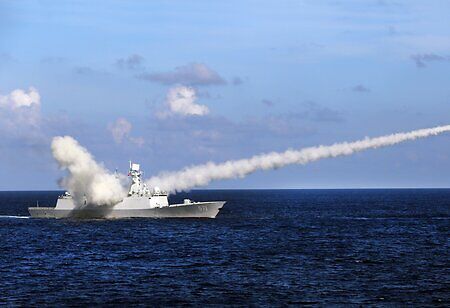
China's Supersonic Anti-Ship Missile will be Able to Travel Further and Faster than Traditional Torpedo


About two million Chinese soldiers serve in the ground forces of the country, wherein their primary responsibilities are to ensure domestic order and protect borders, not to project power. It is estimated that about 20 percent of them are only equipped to move within China. An even smaller number possess the trucks, repair facilities, construction and engineering units, and other mobile assets needed to project power abroad.
In order to boost the equipment facility, China is developing a supersonic anti-ship missile that will be able to travel further and faster than any traditional torpedo.
About China’s Supersonic Anti-Ship Missile
The new anti-ship supersonic missile that measures about five-meter in length (16.4 feet) can cruise at 2.5 times the speed of sound at about 10,000 meters (32,800 feet) before diving and skimming across the waves for up to 20km.
Suppose it is within about 10km of its target. In that case, the missile goes into torpedo mode, traveling underwater at up to 100 meters per second (200 knots) using supercavitation – forming a giant air bubble around it which significantly reduces drag. According to the researchers, it will also be able to change course at will or crash-dive to a depth of up to 100 meters to evade underwater defense systems without losing momentum.
The existing ship defense system was designed to handle such a fast cross-media attack which increases the missile’s penetration capability. As developers need to produce considerable thrust while breathing in either air or water, one of the biggest challenges for the developers is the power system. This problem can be resolved by using boron, a light element that reacts violently when exposed to both, releasing a huge amount of heat.
Experiments with Boron by the US MIlitary and China
The US military had similar programs in the 1950s. Boron was added to the jet fuel in order to increase the power of supersonic bombers. But the project was jilted because the ignited boron particles were hard to control and formed a layer of debris that reduced the power of the engine. The US has similar programs, such as nanotubes made using boron nitride, a combination of boron and nitrogen, which could potentially be used to power hypersonic weapons traveling at speeds above 6,400km/h (4,000 miles per hour).
On the other hand, China is using the same principles to build boron-powered engines designed to work only in the air. Researchers usually choose aluminum or magnesium as fuel to drive supercavitating torpedoes as they react more easily with water. The present boron-powered ramjet engine could work both in the air and underwater.
The engine is developed using unique components, such as adjustable inlets and exhaust nozzles, to maintain the boron’s burn efficiency in different environments, but the biggest change is in the fuel rods. Boron usually accounts for about 30 percent of the total fuel weight in an air-breathing missile because of the many other chemicals required to control and prolong strong combustion. The cross-media ramjet engine uses a fuel-rich solid propellant that burns with the external air or seawater entering into the ram to generate high-temperature gas and thrust through the nozzle. As an ideal power source, it has a high specific impulse and a simple structure for a cross-media anti-ship missile.
The increased Boron content might lead to problems in mass production, ignition, and combustion control. But these problems can be solved by modifying boron particles, improving manufacturing, and studying grain mass properties. Adjusting the thrust of a solid fuel engine is difficult. The boron powder, for instance, behaves as both solid and fluid when injected into the combustion chamber, making physical modeling or regulation of the burning process challenging.
China has made significant progress on solid propellent technology in recent years, including applying multiple layers of coating on nano fuel particles to rein in their explosive behaviors. China Aerospace Science and Technology Corporation built and tested a 3.5-meter wide motor that generates 500 tonnes of thrust; the most powerful rocket engine ever built using a single segment of solid propellant. And the Chinese Academy of Sciences’ new civilian solid-fuelled rocket Lijian One, with advanced combustion control technology, is twice as big as the DF-41, China’s largest road-mobile intercontinental ballistic missile.
According to a materials scientist in Beijing studying the volatile element, China has risks in relying on boron fuels for mass-produced weapons. China imports boron from the US, which is 100 times more expensive than aluminum.
Sky Train
Recently, China launched the world’s first suspended maglev line built with permanent magnets that makes the sky train afloat forever, even without a power supply. The length of the train is about 800-meter (2,600-foot), and powerful magnets rich in rare earth elements are used to produce a constantly repelling force strong enough to lift a train with 88 passengers in the air. Unlike most existing maglev lines, the suspended rail operates about 10 meters above the ground. The train is built in such a way that there is no physical contact with the rail as the train moves underneath the rail at a speed of 80km/h (50mph).
An arm from the train surrounds the rail, and permanent magnets in both the arm and the rail repel each other, suspending the train. Having free-floating conditions and an absence of friction, only a small amount of electricity is needed to propel the train. Only a small amount of electricity is needed to propel the train.

